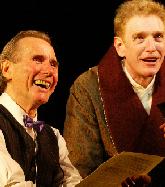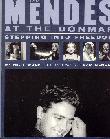SEARCH CurtainUp
REVIEWS
FEATURES
NEWS
Etcetera and
Short Term Listings
LISTINGS
Broadway
Off-Broadway
BOOKS and CDs
OTHER PLACES
Berkshires
London
LA/San Diego
DC
Philadelphia
Elsewhere
QUOTES
On TKTS
LETTERS TO EDITOR
FILM
LINKS
MISCELANEOUS
Free Updates
Masthead
NYC Weather
Address Unknown
|
As for the stern measures that so distress you, I myself did not like them at first, but I have come to see their painful necessity. The Jewish race is a sore spot to any nation that harbors it. I have never hated the individual Jew--yourself I have cherished as a friend, but you will know that I speak in all honesty when I say I have loved you, not because of your race but in spite of it --- from letter written by Martin Schulse |

Jim Dale and William Atherton
(Photo: Carol Rosegg) |
Katherine Kressmann Taylor's 1938 short story sized novel, Address Unknown, managed to give a relevant theme the twisty excitement of a thriller. In editing and directing it for the stage Frank Dunlop has worked overtime to avoid epistolary stasis. The splendid performances of Jim Dale and William Atherton as the two men whose friendship falls victim to Hitler's seduction of even reasonable Germans, make this two-hander worth seeing despite its overly fussy and too hastily paced production.
The play begins in 1932 and ends in 1934 -- four years before the book was published, first in the fabled magazine Story and shortly afterwards as a book credited in The New York Times Book Review as "the most effective indictment of Nazism to appear in fiction." The protagonists are two men who left Germany after World War I and established a successful art gallery in San Francisco. Max Eisenstein (Dale) is Jewish and Martin Schulse (Atherton) is Aryan. Dale, jauntily attired in pinstriped pants and vest, starts off the correspondence tapping away at a '30s style typewriter at his end of a stretch limousine length table; Atherton, in a baronial robe and black boots that hint rather obviously at the uniform underneath, talks into a dictatophone at the other end.
Neither religion or Martin's breaking off a passionate extra-marital affair with Max's beloved younger sister seems to have affected their being close friends as well as business associates. In fact, as the play opens, Max appears to fully understand and sympathize with his partner's decision to take a less active role in the gallery in order to raise his three young sons in the economically depressed Fatherland where his American income enables him to live in princely luxury. However, as Martin becomes increasing infatuated with Hitler and his ability to fire up the dispirited Germans to once again be proud and hopeful, Max hears reports of atrocities against Jews. And so, tension creeps into the correspondence. Eventually Martin suggests an end to their personal correspondence though he still expects his share of the gallery profits to be sent to the bank where mail from the United States arrives uncensored. Max retains enough faith in the erstwhile friendship to entreat Martin to protect his sister who has unwisely put herself in harm's way by appearing in a Berlin theater where she is chased off the stage by the Jew-baiting audience.
When the Hitler-smitten Martin betrays Max's last shred of trust, Dine's depiction of the man's pain is a marvel of unbearably intense, non-verbal acting. Good as this scene is, it also underscores major and minor directorial weaknesses. While James Youmans' set cleverly manifests the subtle similarities and differences in the two locations of (San Francisco and Munich) in which the men compose their missives, Dunlop fails to make it support his efforts to create a sense of the men actually interacting face to face. The hearbreaking scene of Dine's final disillusionment also shows Dunlap to be remiss in doing his homework about a Jewish ritual practice. (Jews don't wear mourning armbands, but torn ribbons).
It is because Eisenstein and Schulse are fictional characters that Kressmann Taylor had the luxury of concluding the correspondence with a twist worthy O'Henry or de Maupassant. The author's build-up of Martin's arrogant assumption that anything can be said to a Jew makes it less of a stretch to see the revenge-prompting letter as a case of arrogance ultimately exceeding common sense. As there would be no twisty ending without this horrendous letter you would be robbed of its impact if I told you more than that the tragic act of betrayal Martin writes about inspire the gentle Eisenstein to devise an ingenious revenge. The title is at the heart of both the betrayal and the revenge. This being a double tragedy, no one has the last laugh, as the concluding image of Max makes gut-wrenchingly clear.
More than half a century has passed. The Nazis have long been defeated, but the power of a madman to tap into the yearning for a leader to restore lost prosperity and national pride is as chilling as ever. Thanks to Dine and Atherton, this production is despite its shortcomings as agreeable to watch as it is disagreeable to contemplate.
| Some Background Notes
The editor of Story Magazine considered Katherine Kressmann's story too potent to be attributed to a woman, and so it appeared with the male by-line, Kressmannn Taylor. While publication in book form earned its author the label of "the woman who jolted America" she continued to use her nom-de-plume along with her first name. Though Eisenstein and Schulse were creatures of Katherine Kressmann Taylor's imagination, her afterword to the book clarified their authenticity: "A short time before the war, some cultivated, intellectual, warmhearted German friends of mine returned to Germany after living in the United States. In a very short time they turned into sworn Nazis. They refused to listen to the slightest criticism about Hitler. During a return visit to California, they met an old, dear friend of theirs on the street who had been very close to them and who was a Jew. They did not speak to him. They turned their backs on him when he held his hands out to embrace them. How can such a thing happen? I wondered . . . " She went on to say "I wanted to write about what the Nazis were doing and to show the American public what happens to real, living people swept up in a warped ideology." The little book has made a big journey -- translated into ten languages; made into a film in 1944 with Paul Lukas as Martin and Morris Carnovsky as Max (with other actors portraying the characters mentioned in the correspondence); a period of neglect which ended with re-publication and an immensely successful second life in 1995 - the 50th anniversary of the fall of Nazism. I've also heard mention of a French film that used the book as a jumping point to move the story into the present with a young writer (Max's daughter) delivering the letters to Martin's son who has been unaware of his father's history. Kathryn Cressman Taylor died in 1996 but her book is still in print, the most recent edition a paperback from Washington Square Press. click here to order |
| ADDRESS UNKNOWN
Written by Kathrine Kressmann Taylor Edited for the theater and directed by Frank Dunlop. Cast: Jim Dale and William Atherton Set Design: James Youmans Costume Design: Jim Stewart Lighting Design: David Lander Sound Design: Matthew Burton Running time: 90 minutes, with no intermission. Tues through Sat @ 8pm, Wd, Sat and Sun at 3pm. Tickets $40-$65 From 5/28/04; opening 6/15/04. Promenade Theatre, 2162 Broadway (At West 76th Street) 212/239-6200 Reviewed by Elyse Sommer based on June 8th press performance |

Retold by Tina Packer of Shakespeare & Co.
Click image to buy.
Our Review

Mendes at the Donmar
Our Review

At This Theater

Leonard Maltin's 2003 Movie and Video Guide

Ridiculous!The Theatrical Life & Times of Charles Ludlam

6, 500 Comparative Phrases including 800 Shakespearean Metaphors by CurtainUp's editor.
Click image to buy.
Go here for details and larger image.



